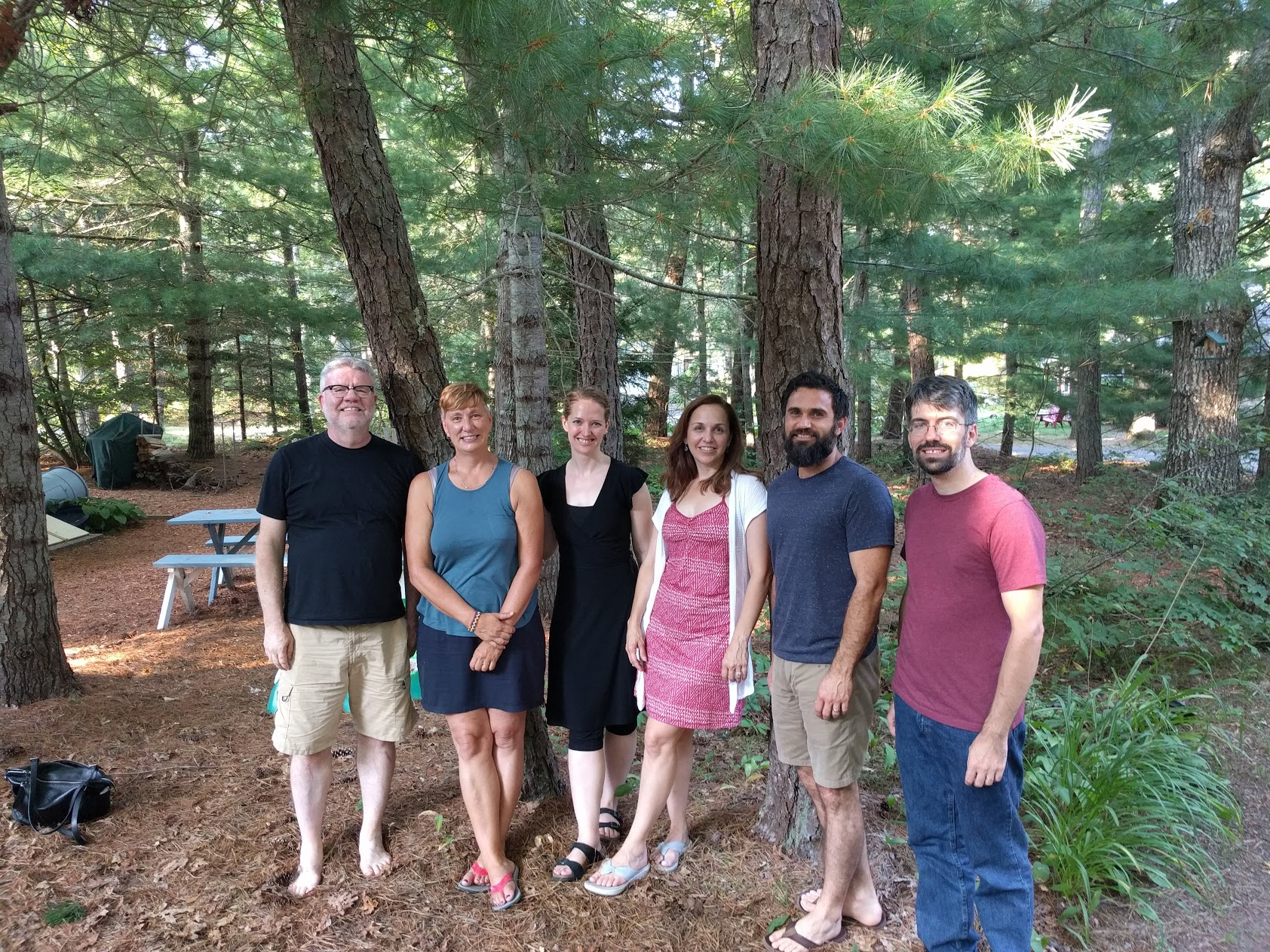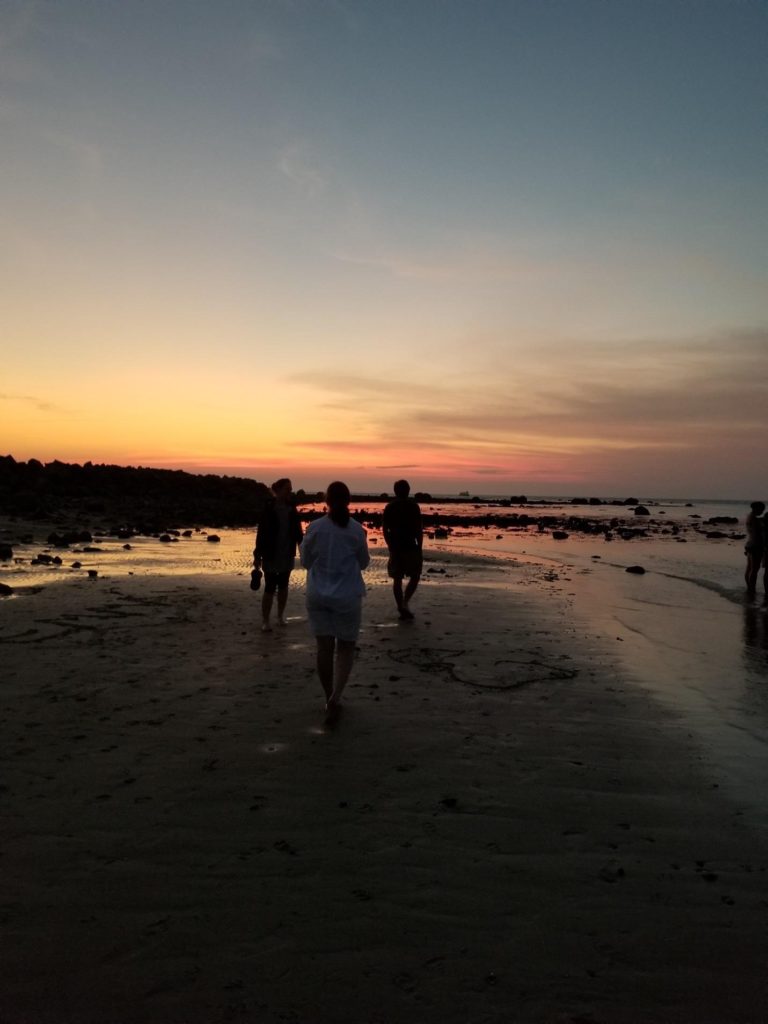Shaping the next generation of resources for the central practices of the church
This article is part of our series on Voices Together, a new worship and song collection coming fall 2020 from MennoMedia, in partnership with Mennonite Church USA and Mennonite Church Canada.

The Voices Together Central Practices Resources Group at their Aug. 2019 writing retreat (L-R): Allan Rudy Froese, Irma Fast Dueck, Sarah Johnson, Heidi Miller, Isaac Villegas, Adam Tice
Irma Fast Dueck is an associate professor of Practical Theology at Canadian Mennonite University in Winnipeg, Canada. She serves on the “Hymnal Steering Committee” for the Voices Together project and co-chaired the Worship Resources for Central Practices group together with Sarah Johnson.
In the autumn of 2016, Sarah Johnson invited me to join her in leading a group of people to evaluate the worship resources for the Central Practices of Mennonite Church Canada and USA – baptism, communion, child dedication, weddings, funerals, church membership, foot washing, as well as resources for leadership and healing ministries. At the time, I had just completed work with the Hymnal Steering Committee, the committee tasked to put in place the current committee responsible for developing a new Mennonite Song Collection for Mennonite Church Canada and USA. While I was grateful for the eager willingness of those gifted people we selected for the committee, and for Bradley Kaufman’s willingness to give leadership as the director/general editor, I recall the distinct feeling of relief not having to bear the weight of responsibility that came with curating a new Mennonite song collection/hymnal. This all changed with the invitation to co-lead the Central Practices Resourcing Group, and I can honestly say I am deeply grateful that I did not escape the weight of that responsibility and the unique opportunities and relationships that formed around this project.
Sarah and I pulled together a small, nimble group to work with us – Heidi Miller, Isaac Villegas, Allan Rudy Froese and Adam Tice. While our group was small, it was expansive in the gifts and skills needed to engage the task – we needed to be theological and pastoral, innovative and tradition bound, Anabaptist and ecumenical, thoughtfully critical and generously affirming. All the while, we needed to love – a Triune God, the church and its diverse people. And we needed to love words.
Our task began with reviewing the resources currently used by congregations in Mennonite Church Canada and USA: the resources at the back of current worship and song collections (Hymnal: a Worship Book, Sing the Story and Sing the Journey), resources found in the Minister’s Manual, as well as other resources we knew were commonly used by our congregations. We evaluated the resources through a number of lenses, continually asking ourselves whether we could use them with minor changes and adjustments, or whether more substantial changes and additions were needed. As we engaged in this evaluative work we also gave attention to what we thought was the theological “core” of each of the Central Practices – what was the practice “saying” and “doing” as we engaged it?
After months of evaluating current resources for Central Practices, it became clear that substantial changes and significant additions were needed for Voices Together. We developed a proposal for each of the resources needed to support each practice in general terms. These proposals were reviewed and approved by the Mennonite Worship and Song Committee. While our group’s work was technically finished after making these recommendations, this opened the door for a second phase of the process: gathering and writing the resources needed for the Mennonite Church’s Central Practices, resources we hoped could sustain the church for another twenty-five or more years. All the members of our group agreed to be part of facilitating the creation of these new resources.
Now that we had assessed what specific resources were needed for each of the Central Practices – which current resources needed editing and “refreshing,” and what new resources needed to be created – we discerned who in our Mennonite community had the gifts and capacity to do the work of finding, writing and editing these resources. While we knew there is an abundance of good worship resources available on the web and worship books, we also knew there is an abundance of gifts within our Anabaptist-Mennonite communities that we could draw on to create resources. We assigned various resources to different writers and waited for the submissions.
When we received the drafts of the new resources, our Central Practices Group met to read through all the submissions and begin the process of editing. Our gathering together at the end of this process was significant. Many of us had never met in person before.
Together we read, we listened, we wrote, we prayed, we baptized, we anointed, we dedicated, we blessed, we shared communion multiple times, as together we tested out the resources and actions accompanying them.
Once we settled on the resources we hoped to include, we invited a group of theologians and pastors from within and beyond the Mennonite tradition to provide detailed feedback. We hoped that the resources created within our Anabaptist-Mennonite community would be in continuity with the broader ecumenical Christian tradition. During this time we also released the resources to Mennonite congregations who volunteered to test them and provide further valuable feedback about how they used and adapted the resources in their contexts and we tested the resources at workshops and events in Colorado, Pennsylvania, Manitoba, and Ontario. We then considered each comment from each source and revised the resources once again.
What did I learn from the process?
How does tradition change?
 As we began the process of discernment around the resources for Central Practices, the image which continually came to mind is a picture I once saw of moving rocks in Death Valley National Park in California – slow moving boulders with a clear path from where they came but no indication of how they moved.
As we began the process of discernment around the resources for Central Practices, the image which continually came to mind is a picture I once saw of moving rocks in Death Valley National Park in California – slow moving boulders with a clear path from where they came but no indication of how they moved.
Through participation in this process, I am reminded again of the slowly moving but dynamic nature of tradition. Mennonites, like all Christians (yes, even evangelical, non-denominations have a tradition!), have a faith that is not generic but practiced within a particular tradition or perhaps, more realistically, within some combination of traditions and historical influences. And again, like all Christians, that tradition which has shaped us in the past is not static but is a dynamic theological tradition which continues to shape our practices. In turn, our practices of worship continue to shape our theology.
It was an ominous task to look at words spoken at communion or baptism or a wedding over the past decades, rocks that have anchored many of us, and to consider the slow dynamic moving within them as the words and gestures continue to be shared now and in years to come. Our group also had to humbly recognize that in the future, others will critically engage and evaluate the texts we have spent the last three years renewing. The Anabaptist-Mennonite tradition is a dynamic tradition; like all traditions, it is slow moving and this is, in many ways, the gift of tradition.
Who owns worship?
We said the following in the Guidelines we developed for the writers of the new resources:
This is a unique writing opportunity as you are writing for the church. In this way, the writing is both yours and the church’s and because of this there will be a careful editing process by a discerning group which will be followed by further testing within the Mennonite community itself. Our hope is that by the end of the process the written liturgies that emerged from within our community will then be owned by the whole community. Again, we are grateful for the significant role you are playing at the beginning of this process of giving words and language to the church.
It was counterintuitive, for me as an academic to tell writers that while they may write something brilliant and beautiful and creative, their name may not be attached to their words. Rather, their words would, through communal discernment and editing, come to belong to the community, the church. This felt awkward at a time when intellectual property and copyrights are vigorously defended and protected. And yet, it points to the very strangeness of worship in the first place: To whom does worship belong?
At a time of worship wars and polarization and defensiveness around preferences and styles, it is strangely refreshing to think that our worship belongs to all of us – to the community in all its diversity. But even more significantly, it rests in a strange, unfathomable God, in whom all the difference and uniqueness is held together in love.
Praise God from whom all blessings flow.
Words are not enough.
I recall the composer John L. Bell sharing the wisdom he learned from his mentor that in ministry three things were vital: the pastor needs to love God, to love people, and to love words. We spent three years working, wrestling, creating, generating, writhing with words that would shape the Central Practices of Mennonite Church Canada and USA. We quickly re-learned “more-with-Less” again and again, as we pared down long convoluted sentences and words into accessible, oral texts. Words were friend and enemy. I confess that words are my “go-to” in shaping theological insights and for creating compelling arguments for what I believe is “right” whether it be belief or action. Yet, words are never enough. “All language has taken an oath to fail to describe Him [God]; any attempt to do so is the height of arrogance and will always declare some kind of war….” said Meister Eckhart (13th century German mystic and theologian).
When it comes to expressing ultimacy in our deepest beliefs, hopes and commitments, our language will always be insufficient. We know intuitively that actions speak louder than words and this holds true as we participate in the embodied actions of our Central Practices. When words and actions are woven together in ritualized practice, we are carried to a place that words alone can never quite take us. While our group worked primarily with words and texts, we were keenly aware of how deeply dependent these words were upon the gestures and actions and participation of living embodied communities. While we are keen to let the words speak, their power depends upon the actions also being given the room to “speak,” whether it be the generous pouring of water, the breaking and sharing of bread, the anointing of oil. This blessing now rests with those who are leading the central practices.
I confess I was surprised at how life-giving and rewarding participation in this arduous process was for me. While we will not know the full impact of the work for years to come, the process of discernment was significant – from the prayerful discernment of a small group of pastor-theologians in Mennonite Church Canada and Mennonite Church USA, extended to a much larger group of writers and contributors (lay and clergy) within the Anabaptist-Mennonite community, and then extended further to include the ecumenical wisdom of those beyond our Mennonite community, and to Mennonite congregations for testing and further discernment. Perhaps the medium really is the message.
Learn more about Voices Together, the new worship and song collection coming Fall 2020 from MennoMedia, in partnership with Mennonite Church USA and Mennonite Church Canada.
.
The views and opinions expressed in this blog belong to the author and are not intended to represent the views of the MC USA Executive Board or staff.



